Zoom
Trash

Henry Faulds. Henry Faulds (1 June 1843 – 24 March 1930) was a Scottish physician, missionary and scientist who is noted for the development of fingerprinting.
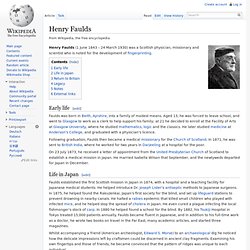
Early life[edit] Faulds was born in Beith, Ayrshire, into a family of modest means. Aged 13, he was forced to leave school, and went to Glasgow to work as a clerk to help support his family; at 21 he decided to enroll at the Facility of Arts at Glasgow University, where he studied mathematics, logic and the classics. He later studied medicine at Anderson's College, and graduated with a physician’s licence. Following graduation, Faulds then became a medical missionary for the Church of Scotland. On 23 July 1873, he received a letter of appointment from the United Presbyterian Church of Scotland to establish a medical mission in Japan.
Life in Japan[edit] Faulds established the first Scottish mission in Japan in 1874, with a hospital and a teaching facility for Japanese medical students. Return to Britain[edit] Legacy[edit] Notes[edit] The History of Fingerprints. Fingerprints offer a reliable means of personal identification.
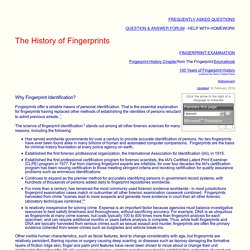
That is the essential explanation for fingerprints having replaced other methods of establishing the identities of persons reluctant to admit previous arrests. 1 The science of fingerprint identification 5 stands out among all other forensic sciences for many reasons, including the following: Other visible human characteristics, such as facial features, tend to change considerably with age, but fingerprints are relatively persistent.
Barring injuries or surgery causing deep scarring, or diseases such as leprosy damaging the formative layers of friction ridge skin, finger and palm print features have never been shown to move about or change their unit relationship throughout the life of a person (and injuries, scarring and diseases tend to exhibit telltale indicators of unnatural change). In earlier civilizations, branding or maiming were used to mark persons as criminals. AD 1400s - Persia 1600s 1685 - Bidloo 1788 - Mayer Dr. Criminal Background Check. A Criminal History Summary—often referred to as a criminal history record or a “rap sheet”—is a listing of certain information taken from fingerprint submissions retained by the FBI in connection with arrests and, in some instances, federal employment, naturalization, or military service.
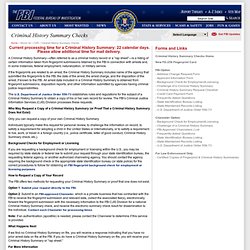
If the fingerprints are related to an arrest, the Criminal History Summary includes name of the agency that submitted the fingerprints to the FBI, the date of the arrest, the arrest charge, and the disposition of the arrest, if known to the FBI. All arrest data included in a Criminal History Summary is obtained from fingerprint submissions, disposition reports, and other information submitted by agencies having criminal justice responsibilities.
The establishes rules and regulations for the subject of a Criminal History Summary to obtain a copy of his or her own record for review. The FBI’s Criminal Justice Information Services (CJIS) Division processes these requests. Option 1: . What Happens Next. Fingerprint. A fingerprint in its narrow sense is an impression left by the friction ridges of a human finger.[1] The recovery of fingerprints from a crime scene is an important method of forensic science.
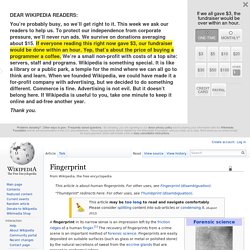
Fingerprints are easily deposited on suitable surfaces (such as glass or metal or polished stone) by the natural secretions of sweat from the eccrine glands that are present in epidermal ridges. Shirley McKie. Shirley McKie (born August 1962) is a former Scottish police detective who was accused by fingerprint analysis staff of the Scottish Criminal Record Office (SCRO) of leaving her thumb print on the bathroom door frame of a murder crime-scene in Kilmarnock on 14 January 1997. [1][2] She denied she had ever been in the house of murder victim Marion Ross, but Detective Constable McKie was initially suspended, then sacked, then arrested by Strathclyde Police in 1998, and tried and acquitted in 1999.
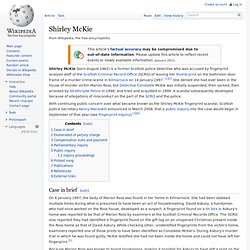
A scandal subsequently developed because of allegations of misconduct on the part of the SCRO and the police. With continuing public concern over what became known as the Shirley McKie fingerprint scandal, Scottish Justice Secretary Kenny MacAskill announced in March 2008, that a public inquiry into the case would begin in September of that year (see Fingerprint Inquiry).[3][4] Case in brief[edit] On 6 January 1997, the body of Marion Ross was found in her home in Kilmarnock. Public inquiry[edit]